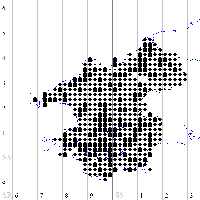The Chaffinch breeds throughout Europe eastwards to western Asia and south to North Africa and the Canary Islands. It is resident and migratory.
Mathew (1894) classed the Chaffinch as a “common resident” and Lockley et al (1949) considered it an “abundant resident” but also noted it was a passage migrant and a numerous winter visitor. Donovan and Rees (1994) agreed with the latter assessment but also plotted breeding distribution in the county using a tetrad grid and attempted to estimate the size of the breeding population. The original breeding distribution survey was conducted between 1994 and 1988 and a repeat survey using the same methods was made between 2003 and 2007.
|
Breeding survey period
|
1984 - 1988
|
2003 - 2007
|
|
Breeding distribution
Red = confirmed
Orange = probable
Yellow = possible
White = no records
|

|

|
|
Total tetrads where found
|
448
|
446
|
|
Confirmed breeding
|
209
|
155
|
|
Probable breeding
|
214
|
278
|
|
Possible breeding
|
25
|
13
|
Little change in distribution was detected between the two surveys. Chaffinches take up territory in late winter but do not normally lay eggs until early May. With such a long period of song it seems unlikely that many were overlooked, even in marginal tetrads.
The population estimate accompanying the 1984 – 88 survey was based on census results from reserves which were mostly woodland plots. The resultant value of 120 pairs per tetrad was applied to the whole county. However, woodland in the county represents only about the equivalent of 11 tetrads, the remainder being mostly farmland which carries smaller densities of Chaffinches. A reappraisal required an assessment which accommodated farmland.
The New Atlas of 1988 – 91, which was not available at the time of the 1984 – 88 assessment, supplied an average density for the UK. If this is applied to the 1984 – 88 distribution, a revised estimate for Pembrokeshire at that time was about 38,000 pairs. It is likely there has been a decrease since then because of the effects of eradicating field headlands and clear felling many tree plantations. Climate change may also have reduced the availability of invertebrate food.
The BBS noted a decrease of 13 % in Wales between1994 – 2007, which if applied to the earlier estimate, suggests a breeding population of 29,000 pairs in Pembrokeshire at the end of 2007.
In Pembrokeshire Chaffinches nest in trees and bushes, being found in woodland, hedgerows, parks and gardens, being absent in the county only from the tops of Mynydd Preseli and most of the offshore islands. It has normally bred on the partly wooded Caldey Island and has nested on Ramsey Island, most recently in 2006.
Graham Rees.
(Covers records up to and including 2008)
References
DONOVAN. J and REES. G. 1994. Birds of Pembrokeshire, Dyfed Wildlife Trust.
GIBBONS.D. W, REID. J. B. & CHAPMAN. R. A. 1993. The New Atlas of Breeding Birds in Britain and Ireland, 1988 – 91, Poyser, London.
LOCKLEY. R. M, INGRAM. C. S. and SALMON. H. M.1949. The birds of Pembrokeshire, West Wales Field Society.
MATHEW. M. 1894. The birds of Pembrokeshire and its islands, R. H. Porter.
RISELY. K, NOBLE. D. G. & BAILLIE.S. R. 2008. The Breeding Bird Survey 2007, BTO Research Report 508, British Trust for Ornithology, Thetford.
 Saturday, May 29, 2010 at 8:55AM
Saturday, May 29, 2010 at 8:55AM 


